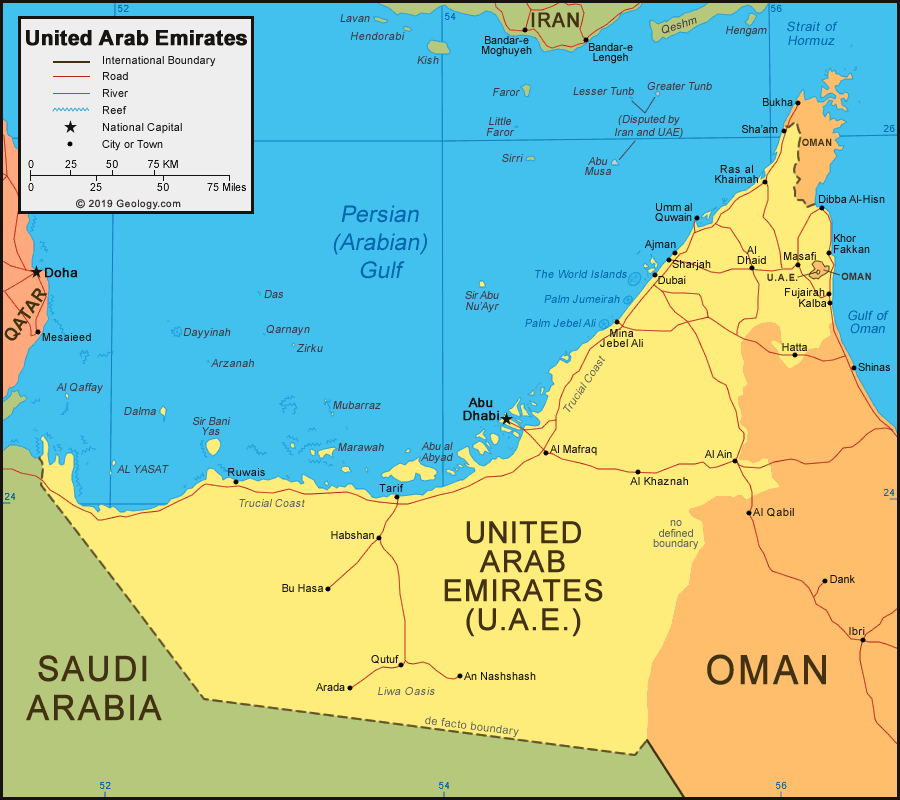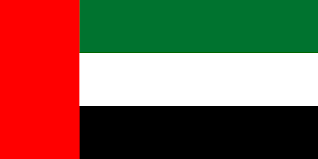Capital: Abu Dhabi
About United Arab Emirates
The United Arab Emirates is slightly smaller in area than Portugal. It is bordered by Saudi Arabia to the west and south and by Oman to the east and northeast. The precise borders of the country have remained a matter of dispute. Despite a 1974 secret agreement between the United Arab Emirates and Saudi Arabia said to have resolved their three border disputes, the agreement’s legal standing is unclear. The United Arab Emirates claims a strip of coastline that borders Qatar to the northwest, which Saudi Arabia claims was ceded to it in the 1974 agreement. It likewise disputes Saudi claims over the Shaybah oil field to the south, while Saudi Arabia (as well as Oman) has at times challenged the emirates’ claim on oases around the city of Al-Ain. Since the early 1990s, moreover, the emirates have been in a dispute with Iran over the ownership of three islands—Abū Mūsā and Greater and Lesser Tunb (Ṭunb al-Kubrā and Ṭunb al-Ṣughrā).
Currency
The dirham is the official currency of the United Arab Emirates. The dirham is subdivided into 100 fils.
Climate
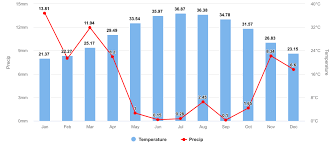
The climate is hot and humid along the coast and is hotter still, but dry, in the interior. Rainfall averages only 4 to 6 inches (100 to 150 mm) annually, though it fluctuates considerably from year to year. The average January temperature is 64 °F (18 °C), while in July the temperature averages 91 °F (33 °C). Summertime highs can reach 115 °F (46 °C) on the coast and 120 °F (49 °C) or more in the desert. In midwinter and early summer, winds known as the shamāl (Arabic: “norther”) blow from the north and northwest, bearing dust and sand.
Language
The official language of the United Arab Emirates is Arabic. Modern Standard Arabic is taught in schools, and most native Emiratis speak a dialect of Gulf Arabic that is generally similar to that spoken in surrounding countries. A number of languages are spoken among the expatriate commu+nity, including various dialects of Pashto, Hindi, Balochi, and Persian. English is also widely spoken.
About three-fifths of the population is Muslim, of which roughly four-fifths belong to the Sunni branch of Islam; Shiʿi minorities exist in Dubai and Sharjah. There are also small but growing numbers of Christians and Hindus in the country.
Economy
The federation’s economy is dominated by the petroleum produced primarily in the Abu Dhabi emirate. The wealthiest of the emirates, Abu Dhabi contains one of the largest concentrations of the world’s proven oil reserves and contributes a significant portion of the national budget. The emirate of Dubai, whose economy is centred more on business than on oil, serves as a commercial and financial hub for the region and leads the country in economic diversification.
Agriculture and fishing
Agricultural production—centred largely in the emirates of Ras al-Khaimah and Fujairah, in the two exclaves of ʿAjman, and at Al-Ain—has expanded considerably through the increased use of wells and pumps to provide water for irrigation. However, agriculture contributes only a small fraction of gross domestic product (GDP) and employs less than one-tenth of the workforce. Dates are a major crop, as are tomatoes, cucumbers, and eggplants, and the United Arab Emirates is nearly self-sufficient in fruit and vegetable production. The country also produces enough eggs, poultry, fish, and dairy products to meet its own needs but must import most other foodstuffs, notably grains. The Arid Lands Research Centre at Al-Ain experiments with raising crops in a desert environment. Most commercial fishing is concentrated in Umm al-Quwain, and the emirates have one of the largest fishing sectors in the Arab world.
Resources and power
Oil was discovered in Abu Dhabi in 1958, and the government of that emirate owns a controlling interest in all oil-producing companies in the federation through the Abu Dhabi National Oil Company (ADNOC). Abu Dhabi is responsible for about 95 percent of the country’s oil production, and production of petroleum and natural gas contributes about one-third of the nation’s GDP, even though the oil and gas sector employs only a tiny fraction of the workforce. The largest petroleum concessions are held by an ADNOC subsidiary, Abu Dhabi Marine Operating Company (ADMA-OPCO), which is partially owned by British, French, and Japanese interests. One of the main offshore fields is located in Umm al-Shāʾif. Al-Bunduq offshore field is shared with neighbouring Qatar but is operated by ADMA-OPCO. A Japanese consortium operates an offshore rig at Al-Mubarraz, and other offshore concessions are held by American companies. Onshore oil concessions are held by another ADNOC company, the Abu Dhabi Company for Onshore Oil Operations, which is likewise partially owned by American, French, Japanese, and British interests. Other concessions also are held by Japanese companies.
Petroleum production in Dubai began in 1969. There are offshore oil fields at Ḥaql Fatḥ, Fallah, and Rāshid. The emirate long maintained a controlling interest in its oil fields and took full control of oil production in 2007. At its peak, Dubai produced about one-sixth of the country’s total output of petroleum. Production dwindled to a negligible amount, however, as the emirate diversified its economy. Sharjah began producing oil in 1974; another field, predominantly yielding natural gas, was discovered six years later. In 1984 oil production began off the shore of Ras al-Khaimah, in the Persian Gulf.
The federation’s natural gas reserves are among the world’s largest, and most fields are found in Abu Dhabi. In the late 1990s the United Arab Emirates began investing heavily to develop its natural gas sector, both for export and to fire domestic thermal power plants.
Because it relies on energy-intensive technologies such as water desalination and air-conditioning and because subsidies on fuel have encouraged wasteful energy use, the United Arab Emirates has one of the world’s highest per capita rates of energy consumption. Despite its large hydrocarbon reserves, rapidly increasing domestic demand driven by population growth and industrialization in the first decade of the 21st century forced the emirates to import natural gas and to draw upon petroleum reserves at a fraction of the export price.
To safeguard future hydrocarbon production, the federation began to explore other sources for domestic energy. In 2009 the emirates contracted the Korean Electric Power Company to build four nuclear reactors in the country by 2020. Abu Dhabi and Dubai also began to invest in renewable energy. In 2013 Abu Dhabi opened what, at the time, was one of the world’s largest solar power plants, a 100-megawatt facility capable of powering up to 20,000 homes.
Manufacturing
The emirates have attempted to diversify their economy to avoid complete dependence on oil, and manufacturing has played a significant part in that effort. A petrochemical industrial complex has been established at Al-Ruways, 140 miles (225 km) southwest of Abu Dhabi city, with a petroleum refinery, a gas fractionation plant, and an ammonia and urea plant. Dubai’s revenues have been invested in projects such as a dry dock and a trade centre; its first airport was expanded in the 2000s, while a second airport was built near the port of Jebel Ali, and additional hotels have been built, including the striking Burj al-ʿArab (“Tower of the Arabs”), which opened in the late 1990s. The Burj Khalifa (“Khalifa Tower”) skyscraper in Dubai city became the world’s tallest building and the tallest freestanding structure when it opened in 2010. Sharjah has built a cement plant, a plastic-pipe factory, and paint factories. Manufacturing accounts for less than one-tenth of GDP in the country overall.
Education
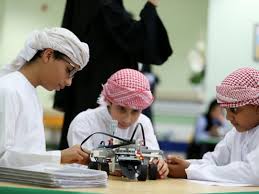
Education in the emirates is free and mandatory at the primary and secondary levels for all children from age 6 to 18. There are a number of fine institutions of higher education in the emirates, and both boys and girls attend public school. Female students far outnumber males at the United Arab Emirates University, which opened at Al-Ain in 1977, and at the Higher Colleges of Technology system (1988) throughout the emirates. Zayed University (1998) was established to provide women with technical education, though in 2008 it began admitting men as well. Overall, women make up approximately 70 percent of university graduates at Emirati universities, although men are much more likely than women to go abroad for university study. By the 2010s the vast majority of the population was literate.
Security
The emirates’ defense forces were merged in 1976, but the forces in Dubai and Abu Dhabi have retained some independence. The Supreme Council has made the right to raise armed forces a power of the national government. In 2006 the Supreme National Security Council, which included the president, prime minister, and chief of staff of the armed forces, among others, was formed to deal with the emirates’ security needs. The number of uniformed military personnel is high for a country the size of the emirates, as is total military spending per capita. Most personnel are in the army, but the emirates maintain a small navy and air force, and a large number of expatriates serve in the military.
Health and welfare

Hospital services are free to nationals, and medical services are concentrated in Dubai and Abu Dhabi, which have numerous hospitals, child welfare clinics, and other health facilities. In the late 1990s the emirates began privatizing health care, which led to a significant rise in the number of hospitals and physicians. The government subsidizes health insurance for its citizens, and thus public spending on health care has also increased alongside the increase in privatization.
Housing
A considerable proportion of government spending, at both the federal and local levels, is devoted to constructing and financing housing and to developing civil infrastructure such as power, water, and waste removal. The federation government makes housing available to citizens through direct low-interest loans, subsidies on rental units, and grants of housing at no charge, and thousands of Emiratis have taken advantage of these programs.
Culture

The cultural traditions of the United Arab Emirates are rooted in Islam and resonate with the wider Arab world, especially with the neighbouring states of the Persian Gulf. The federation has experienced the impact of Islamic resurgence, though the practice of Islam in the emirates is generally less austere than in Saudi Arabia. Tribal identities in the United Arab Emirates remain fairly strong, despite urbanization and the presence of a large expatriate community, and the family is still considered the strongest and most cohesive social unit.
Cuisine
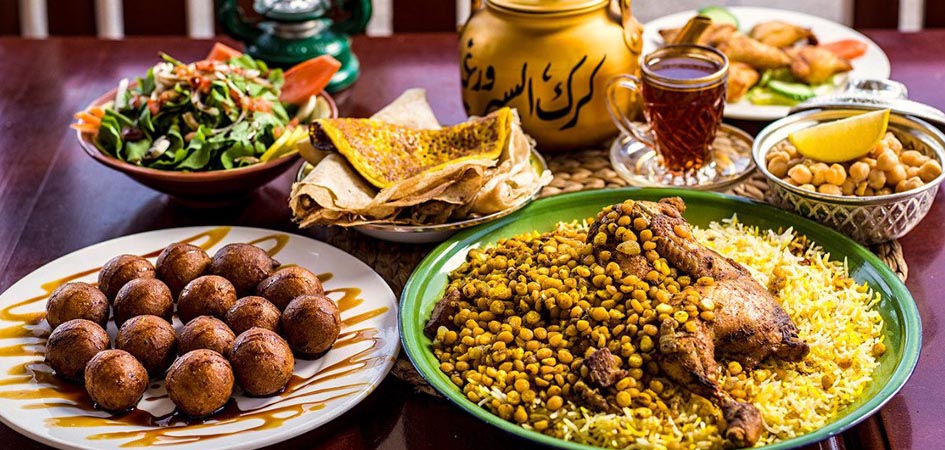
Emirati cuisine reflects the variety of cultural influences that the country has experienced over the centuries. Hummus, fūl (spiced bean paste), falafel, and shawarma (broiled meat served on flatbread) are dishes standard to the Arab world, whereas the influence of Iranian cuisine can be seen in the Emirati preference for rice as a staple and ingredients such as saffron, cardamom, and rose water as flavouring in desserts. Among the favorite dishes is makbūs—poultry, meat, or fish atop a bed of rice spiced with seasonings and dried lime. As in all countries of the region, lamb and chicken are the preferred meats, and fresh fruits—including dates, figs, lemons, and limes—and vegetables and flatbread (khubz) are daily fare. The preferred drink is coffee, served in the popular fashion—hot, strong, and sweet.


